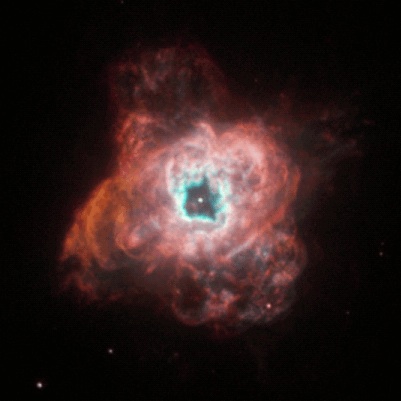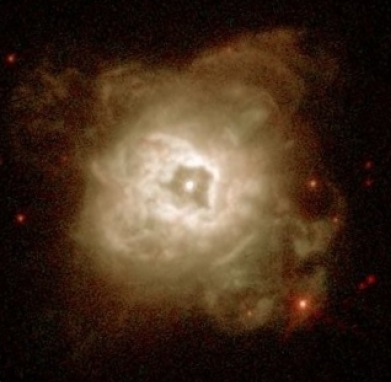NEAT SOUTHERN PLANETARIES : 14
NGC 5315 in Circinus
NGC 5315 / He2-100 / Sa2-100 / Wray 16-140 / PK
309-4.2 / PN G309.1-04.3 (13540-6631) [U452] lies in the
southern constellation of Circinus. It planetary nebula
nature was discovered in 1883 spectroscopically by Scottish
born Ralph Copeland (1837-1905), but was oddly not noticed
in the early sweeps between 1834 and 1838 by the usually
highly meticulous observer, John Herschel. It was J.L.E.
Dreyer who recorded in the NGC as
“…;stellar=10.5 mag.”, giving the
catalogued number NGC 5315. This PNe is bright 9.6v / 9.8p
magnitude of high surface brightness, and to me appears
like a very pretty small nebulous smudge. Visually, I
thought the planetary was slightly elongated at about PA
50°, whose observed diameter is between 3 and 5
arcsec. Photographically it is claimed as about 6.1 arcsec.
Sky Catalogue 2000.0 (1986) lists the diameter as 5.0
arcsec. Using the Vorontsov-Velyaminov Classification is
given as Class II — 2. Its central PNN star is 11.3v
and 13.4p magnitude.
NGC 5315 is placed 29′E of the shared Circinus/
Musca border, and can be readily found some 5.2°WSW
(PA 248°;) from α
Cir / Alpha Circini /
Δ166 (14425-6458).
Alternatively, use β
Mus / Beta Muscae / R207 (12463-6806), lying 6.7°E
(PA 84°) away, with NGC 5315 found conveniently about
halfway between α Cir and
β Mus.
Observations of NGC 5315
E.J. Hartung writes in AOST1 and AOST2:
“In a beautiful field with a
bright pale yellow star [SAO 252498] 4′ preceding is
this bright small nebula showing a strong elliptical prism
image with a smaller fainter one on the violet side, from
oxygen and hydrogen respectively. The nebulae is fairly
well defined, about 5 arcsec across and 10.5cm (not 3
arcsec as quoted in the Companion to the
Uranometria shows it clearly as a bluish star while
the prism image is easy in a 7.5cm (AOST1 continues) R is
estimated as about 3,500 pc.”
Kent Wallace using a 8-inch SCT.from Western Australia
on 2nd August 1999 describes;
“At 62.5× can see directly as
a relatively bright star with an even brighter one nearby.
Through the O-III filter the PN becomes brighter than its
mate. Good response to the O-III & UHC filters. No response
to the Hβ filter. At
100× the PN still appears stellar. At 200× the PN
looks slightly non-stellar.”
Sanford says;
“…appears as a small,
disk-shaped object, differing from a star only because of
its bluish-green colour in low-power eyepieces. A
high-power eyepiece will show a fairly bright, featureless
disk about 5 arcseconds in diameter. The central [PNN] star
is listed at mag 11.4.”
Franschoek using 15cm f/8.6 Newtonian and observed this
planetary from a mountain pass summit, haze, thin clouds.
Here he quotes;
“Easy as a star of 10th magnitude,
perhaps with an envelope. Up to 186× shows no obvious
disc. A moderately bright field star conveniently nearby
allows precise focussing to be checked.”
Technical Data on MGC 5315
The expansion velocity of the nebula is 37.5
km.s-1. Total mass of the nebulosity is 0.01,
ionised by a moderately strong electron density of
2×104. In 1981, infrared observations
indicates that the nebulosity contains significant numbers
of Silicon Carbide (SiC) particles, with an average
particle size about 11.3μm.
Ratio of Carbon to Oxygen, [C/O] is 2.5 — moderately
high in abundance compared to most PNe. NGC 5315 is
relatively strong radio source when compared to most
planetaries. The envelope is expanding at the relatively
pedestrian rate of >4km.s-1.


First determined by the International Ultra-Violet
Explorer (IUE), the central star is spectral class WC6
with an effective surface temperature of 70,000K. This
satellite observatory also confirmed its rare PN Type I
— a unique evolution classes first defined by
Peimbert in 1978. NGC 5315 PNN has the luminosity estimated
to be a thousand times that of the Sun.
The spectral signature implies that the radial velocity
is -32km.s-1 away from us. Distance is presently
estimated between 1.3kpc and 4.2kpc. (4,150 to 13,600ly.)
Sky Catalogue 2000.0 quotes the value as the mean of the
two, 2.8kpc. It seems that the problem of interstellar
absorption is particularly uncertain towards this region of
the sky. I.e. E(B-V)=0.41. Lower values of 1.3kpc assumes
no absorption and is based on the extinction distance. It
is likely that the distance of the planetary is likely
about 3.0kpc., though Gathier, Pottasch & Pel (1986) finds
an error prone 2620±1030pc.
Surrounding Fields of NGC 5315
Sa3-23 (13525-6623) is another PNe in the same
field as NGC 5315. I did not see this in 20cm even when
using the O-III filter. Lying merely 11′NW (PA
311°), its distinctive location is easily identified
between the midway point between two stars at 9.5 and 8.8,
respectively. The latter being 1.6′ENE at PA
60°. Using the ESO-Strasbourg Catalogue of
Planetary Nebula shows no listing of magnitude, though
the size is given as 17 arcsec. Looking at the STScI image,
it is unlikely that apertures below 40cm would see it.
Those with large apertures when checking out NGC 5315, may
like to report any visual sightings.
Δ145
(13546-6654) was found by Dunlop in 1837 and is located
23′S of NGC 5315. The current separation is 24.1
arcsec along PA 48°. Since discovery, little has
changed, except for the small 2° decrease in PA.
Magnitudes are stated as 8.2v and 9.2v, though I thought
the difference in Δm was
more like 0.7. According to my observing log, and using the
32mm Erfle, I could fit both objects within
“…the very starry field.” Finding
this bluish-white/ white pair (B9/A0) alone is more than
worthwhile!
Last Update : 04th November 2011
Southern Astronomical Delights ©
(2011)
For any problems with this Website or Document please
e-mail me.
|